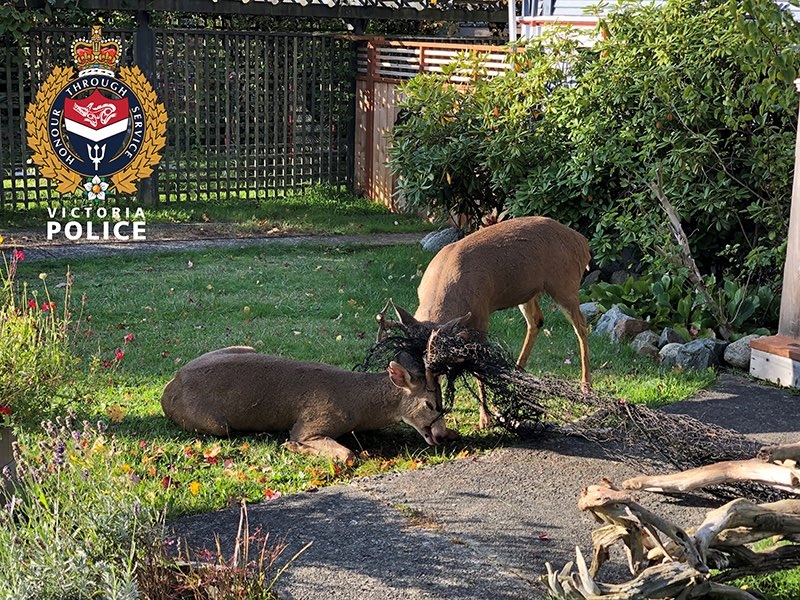Debra
The Living Force
This article was in the news very briefly, now its crickets...
I am suspicious about the type of "virus" they are dying from, and how fast it is spreading on the island.
The first "injections" used here on Vancouver Island, in March, April and May were Astrazenica, which are Frankensteined using chimpanzee Adenovirus as a vector.
The deer started dying in May and June, and this article was written September 30:
Adenovirus Hemorrhagic Disease (AHD) was first detected last year on the Gulf Islands but has since made its way to the big island.
“We’ve seen it spread to Vancouver Island and have had positive detection as far south as Sooke and now as far north as Merville,” said Caeley Thacker, a wildlife veterinarian.
When the disease first made its way to B.C., officials thought fertilizer was the cause, but after further investigation found it was AHD.
The virus was first discovered in California in the 1990s. It most severely affects black-tailed deer but mule deer, white-tailed, elk and moose are all susceptible — especially their fawns.
Affected animals are often found dead but in good body condition with no signs of trauma, though there are some visible symptoms.
My note here***I wonder what the yearly flu "injections" contained in the early 1990's....
“We see signs of difficulty breathing, foaming from the nose or mouth, diarrhea and just general signs of being unwell,” said Thacker.
The disease is usually rapid and fatal as it damages small blood vessels in the lungs and intestines. Chronic signs include ulcers and abscesses in the mouth and throat, likely the cause of drooling, that can lead to weight loss and death.
It spreads through nose-to-nose contact but there is no evidence humans, pets and livestock are at risk.
“It’s a virus that can be aerosolized but it requires deer to be in close contact to transmit and pick up,” added Thacker.
There is no cure or vaccine for AHD, but there are some actions people can take to prevent the spread.
“Avoid any activities that would cause deer to congregate such as providing food or water sources,” said Thacker.
The province is tracking the spread, rather than the prevalence of the disease, but Thacker said she has had over 300 anecdotal reports of deer suspicious of having the virus.

 www.cheknews.ca
www.cheknews.ca
Last month, I saved this article about deer all over North America having SARS-CoV-2 antibodies.
"APHIS collected a total of 481 samples between January 2020 and March 2021 from Illinois, Michigan, New York, and Pennsylvania. We detected SARS-CoV-2 antibodies in 33 percent of those samples. The results varied by State (Illinois = 7 percent of 101 samples contained antibodies; Michigan = 67 percent of 113 samples; New York = 19 percent of 68 samples; and Pennsylvania = 31 percent of 199 samples)."
"White-tailed deer are susceptible to SARS-CoV-2, are abundant in the United States (approximately 30 million*), and often come into close contact with people. Given these factors, we felt it prudent to further investigate SARS-Cov-2 in wild deer. Studying the susceptibility of certain mammals, such as deer, to the SARS-CoV-2 virus helps to identify species that may serve as reservoirs or hosts for the virus. It also helps us understand the origin of the virus and predict its impacts on wildlife and the risks of cross-species transmission"
I am suspicious about the type of "virus" they are dying from, and how fast it is spreading on the island.
The first "injections" used here on Vancouver Island, in March, April and May were Astrazenica, which are Frankensteined using chimpanzee Adenovirus as a vector.
The deer started dying in May and June, and this article was written September 30:
Deadly virus killing hundreds of deer is spreading on Vancouver Island
A fast-spreading virus is responsible for the deaths of hundreds of deer on Vancouver Island, according to wildlife management officials.Adenovirus Hemorrhagic Disease (AHD) was first detected last year on the Gulf Islands but has since made its way to the big island.
“We’ve seen it spread to Vancouver Island and have had positive detection as far south as Sooke and now as far north as Merville,” said Caeley Thacker, a wildlife veterinarian.
When the disease first made its way to B.C., officials thought fertilizer was the cause, but after further investigation found it was AHD.
The virus was first discovered in California in the 1990s. It most severely affects black-tailed deer but mule deer, white-tailed, elk and moose are all susceptible — especially their fawns.
Affected animals are often found dead but in good body condition with no signs of trauma, though there are some visible symptoms.
My note here***I wonder what the yearly flu "injections" contained in the early 1990's....
“We see signs of difficulty breathing, foaming from the nose or mouth, diarrhea and just general signs of being unwell,” said Thacker.
The disease is usually rapid and fatal as it damages small blood vessels in the lungs and intestines. Chronic signs include ulcers and abscesses in the mouth and throat, likely the cause of drooling, that can lead to weight loss and death.
It spreads through nose-to-nose contact but there is no evidence humans, pets and livestock are at risk.
“It’s a virus that can be aerosolized but it requires deer to be in close contact to transmit and pick up,” added Thacker.
There is no cure or vaccine for AHD, but there are some actions people can take to prevent the spread.
“Avoid any activities that would cause deer to congregate such as providing food or water sources,” said Thacker.
The province is tracking the spread, rather than the prevalence of the disease, but Thacker said she has had over 300 anecdotal reports of deer suspicious of having the virus.

Deadly virus killing hundreds of deer is spreading on Vancouver Island
A fast-spreading virus is responsible for the deaths of hundreds of deer on Vancouver Island, according to wildlife management officials.
 www.cheknews.ca
www.cheknews.ca
Last month, I saved this article about deer all over North America having SARS-CoV-2 antibodies.
"APHIS collected a total of 481 samples between January 2020 and March 2021 from Illinois, Michigan, New York, and Pennsylvania. We detected SARS-CoV-2 antibodies in 33 percent of those samples. The results varied by State (Illinois = 7 percent of 101 samples contained antibodies; Michigan = 67 percent of 113 samples; New York = 19 percent of 68 samples; and Pennsylvania = 31 percent of 199 samples)."
"White-tailed deer are susceptible to SARS-CoV-2, are abundant in the United States (approximately 30 million*), and often come into close contact with people. Given these factors, we felt it prudent to further investigate SARS-Cov-2 in wild deer. Studying the susceptibility of certain mammals, such as deer, to the SARS-CoV-2 virus helps to identify species that may serve as reservoirs or hosts for the virus. It also helps us understand the origin of the virus and predict its impacts on wildlife and the risks of cross-species transmission"




